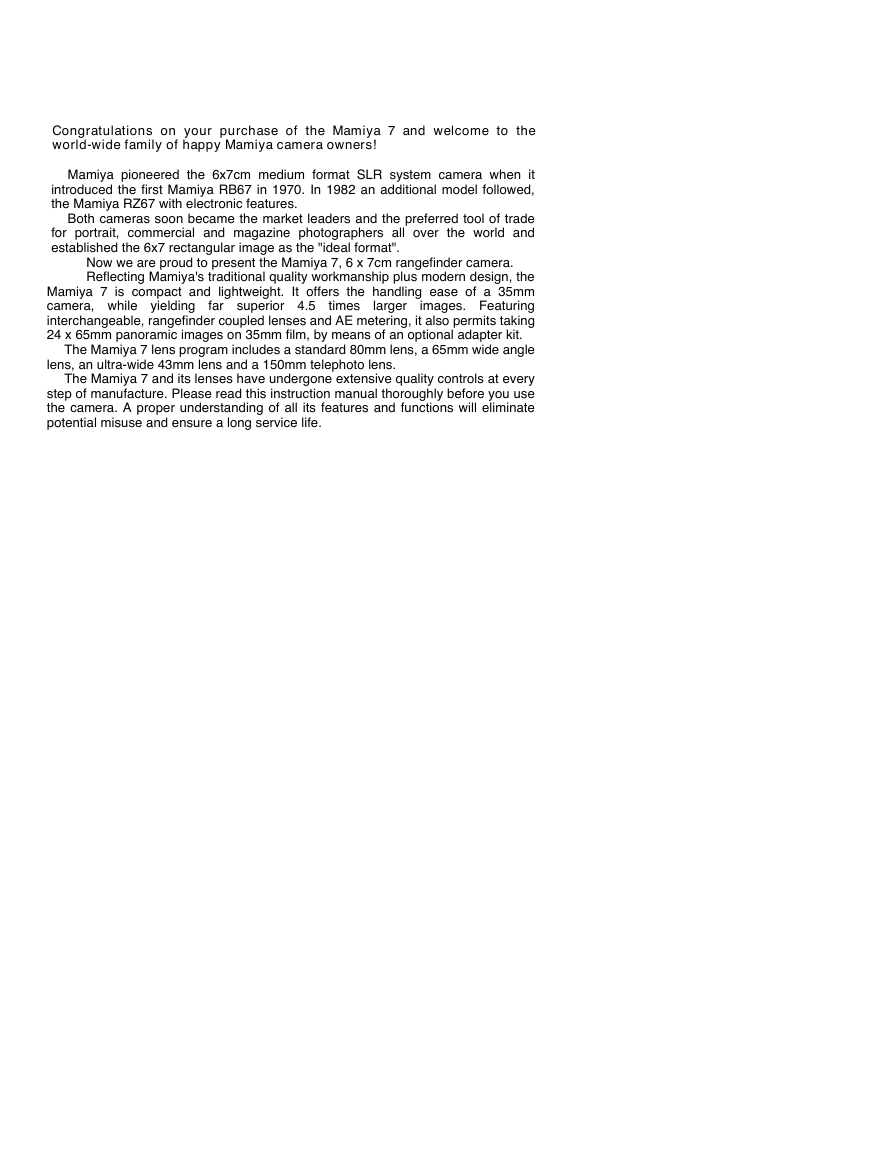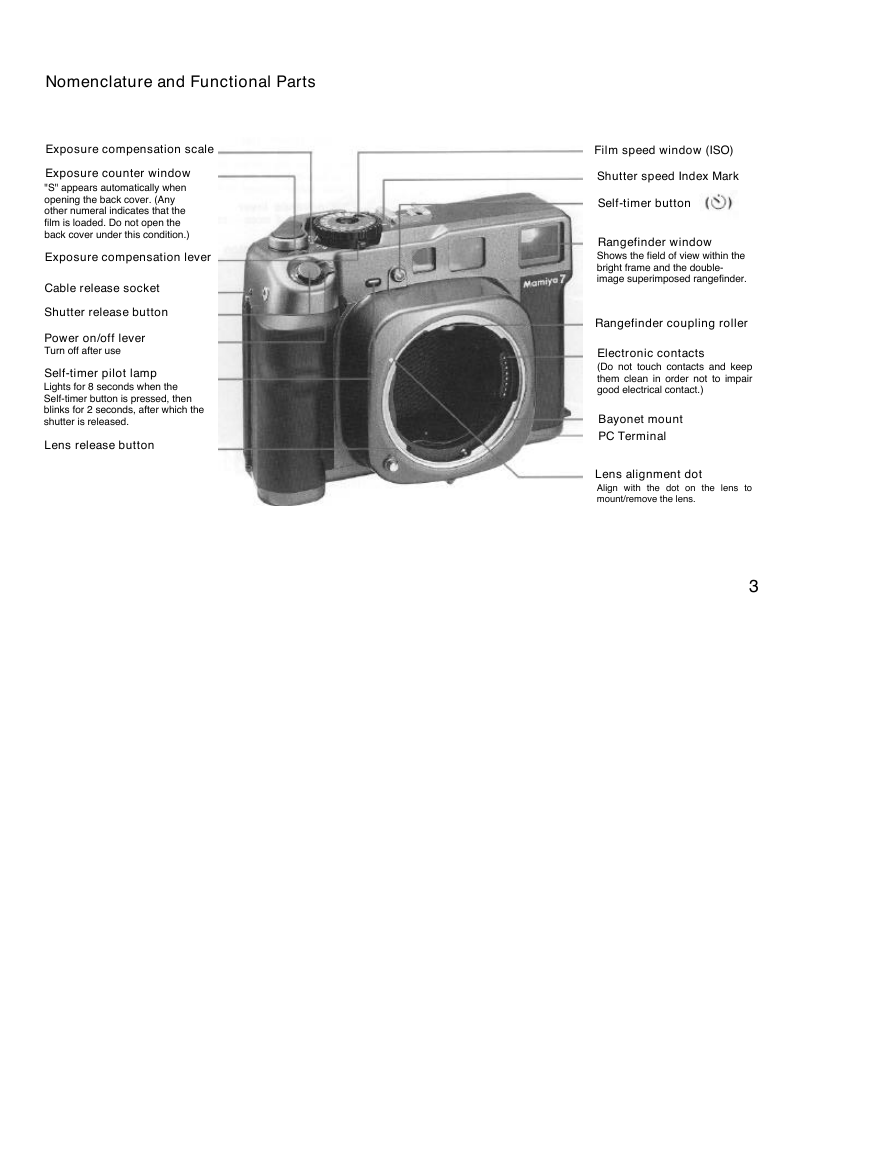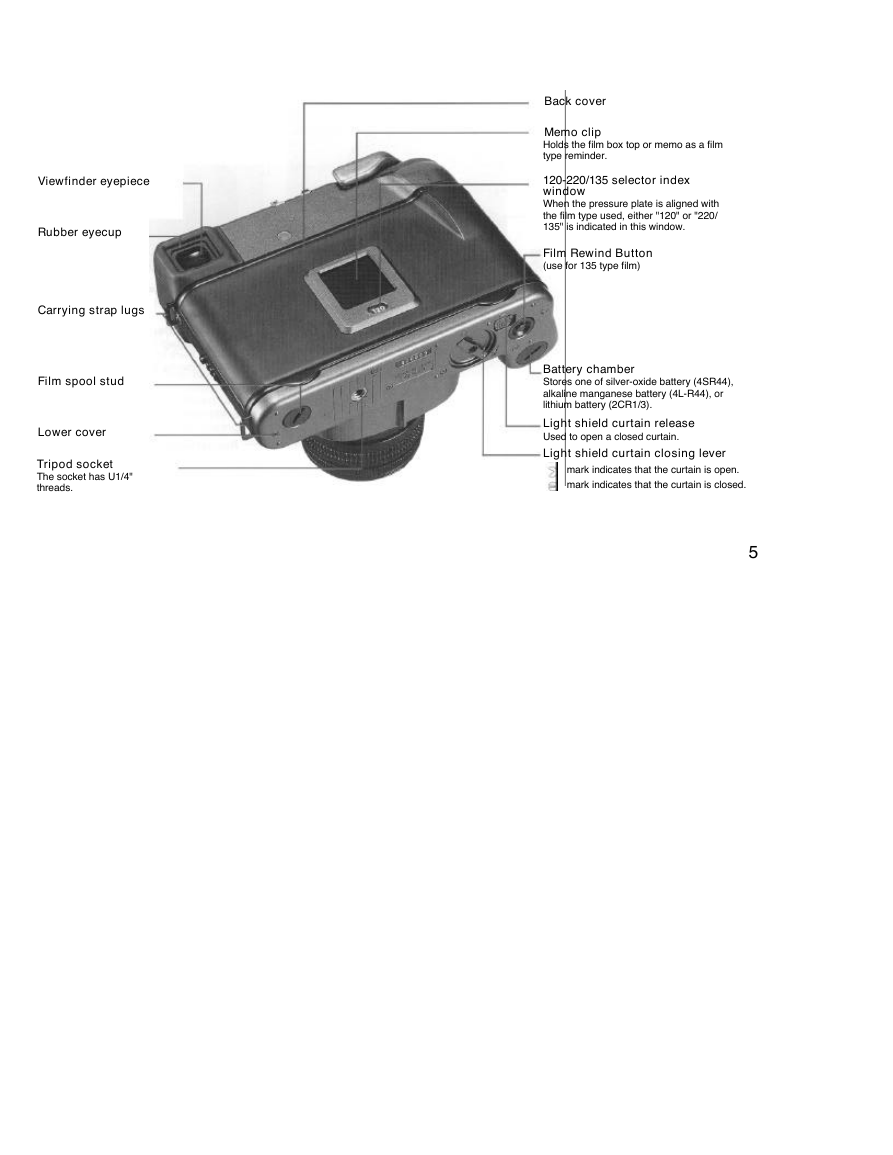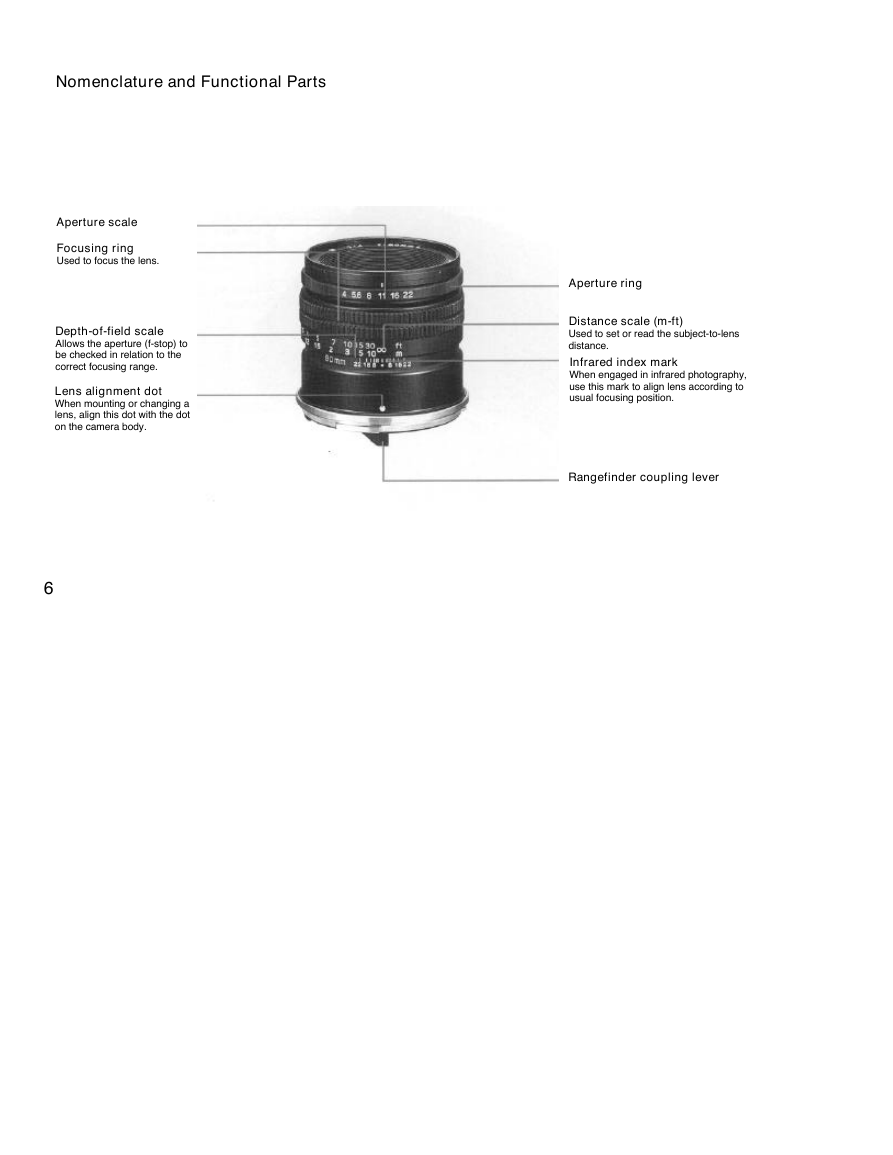�
Congratulations on your purchase of the Mamiya 7 and welcome to the
world-wide family of happy Mamiya camera owners!
Mamiya pioneered the 6x7cm medium format SLR system camera when it
introduced the first Mamiya RB67 in 1970. In 1982 an additional model followed,
the Mamiya RZ67 with electronic features.
Both cameras soon became the market leaders and the preferred tool of trade
for portrait, commercial and magazine photographers all over the world and
established the 6x7 rectangular image as the "ideal format".
Now we are proud to present the Mamiya 7, 6 x 7cm rangefinder camera.
Reflecting Mamiya's traditional quality workmanship plus modern design, the
Mamiya 7 is compact and lightweight. It offers the handling ease of a 35mm
camera, while yielding
images. Featuring
interchangeable, rangefinder coupled lenses and AE metering, it also permits taking
24 x 65mm panoramic images on 35mm film, by means of an optional adapter kit.
far superior 4.5
larger
times
The Mamiya 7 lens program includes a standard 80mm lens, a 65mm wide angle
lens, an ultra-wide 43mm lens and a 150mm telephoto lens.
The Mamiya 7 and its lenses have undergone extensive quality controls at every
step of manufacture. Please read this instruction manual thoroughly before you use
the camera. A proper understanding of all its features and functions will eliminate
potential misuse and ensure a long service life.
�
Contents
Mamiya 7, the ultimate 6 x 7
rangefinder camera ....................................................2
Nomenclature and Functional Parts ..........................3
Inserting Battery .........................................................7
Removing Camera Body Cap .....................................7
Opening/Closing Light Shield Curtain ......................8
Mounting/Removing Lenses ......................................9
Battery Check ...........................................................10
Releasing the Shutter ...............................................11
Before Loading the Film ...........................................12
Loading the Film .......................................................13
Shutter Speed ...........................................................15
Shutter Release Button ............................................16
LED Indicators in the Viewfinder .............................16
Focusing the Lens ....................................................18
Taking Photographs .................................................19
AE (Automatic Exposure) Photography ..................20
AE Lock (AEL) Photography ....................................20
Manual Photography ............................................... 21
Self-Timer ................................................................ 21
Depth-of-Field .......................................................... 22
Diopter Correction Lenses ..................................... 22
Exposure Compensation ........................................ 23
Time Exposures ...................................................... 23
Flash Photography .................................................. 24
Infrared Photography .............................................. 24
How to Hold the Camera ......................................... 25
Trouble Shooting .................................................... 26
Lenses ...................................................................... 27
Accessories.............................................................. 28
System Chart............................................................ 29
Specifications........................................................... 30
Common Sense Camera
Care and Practice..................................................... 31
�
Mamiya 7, the ultimate 6x7 rangefinder camera.
The Mamiya 7 is the only camera in the world that has these
exclusive features:
• Ideal 6x7cm film format that enlarges to standard photographic
and industrial paper sizes without cropping and without wasting
film. A size that can be viewed with the naked eye and that is
easy to retouch.
• Lightweight, compact, "quick on the draw" and ergonomically
designed to fit in your hand like a glove.
• Crisp, accurate, broad based, split-image rangefinder, that is
easy to focus, even in poor light.
• Bright viewfinder with frame lines that are automatically indexed
to match the focal length of lens in use and that automatically
adjust for parallax.
• Interchangeable, world-class Mamiya lenses, utilizing the latest
optical glasses and computer aided design and that take
advantage of the camera's short flange focal distance (there is no
mirror box) to reach new heights in lens quality.
• Precision, super quiet, electronic shutter with speeds from 4 to
1/500 sec., flash synchronized at all speeds.
• Built-in "dark slide" curtain that permits changing lenses with
film in camera.
• Precision AE (automatic exposure) meter with manual
overrides.
• Selftimer (delayed action release) with automatic turn-off.
• Optional external battery case to wear inside clothing in
extreme cold.
• Optional panoramic adapter that permits use of 35mm film and
yields 24x65mm images.
• Built with typical Mamiya quality for hard professional use and
long service life.
�
Nomenclature and Functional Parts
Exposure compensation scale
Exposure counter window
"S" appears automatically when
opening the back cover. (Any
other numeral indicates that the
film is loaded. Do not open the
back cover under this condition.)
Exposure compensation lever
Cable release socket
Shutter release button
Power on/off lever
Turn off after use
Self-timer pilot lamp
Lights for 8 seconds when the
Self-timer button is pressed, then
blinks for 2 seconds, after which the
shutter is released.
Lens release button
Film speed window (ISO)
Shutter speed Index Mark
Self-timer button
Rangefinder window
Shows the field of view within the
bright frame and the double-
image superimposed rangefinder.
Rangefinder coupling roller
Electronic contacts
(Do not touch contacts and keep
them clean in order not to impair
good electrical contact.)
Bayonet mount
PC Terminal
Lens alignment dot
Align with the dot on the lens to
mount/remove the lens.
3
�
Nomenclature and Functional Parts
Hot Shoe for mounting
electronic flash
Shutter speed dial
When A or AEL on the shutter speed dial is aligned with the indicator
on the camera body, the dial will lock in place. To unlock it, rotate the
dial while pushing in the AE lock (AEL) release button located in the center.
Film advance lever
Advance until it stops - the shutter is then cocked.
Film setting index
dots
Pressure plate
Set the pressure plate
position according to the film
type (120 or 220/135) used.
Spool release levers
When replacing the film, be sure to
push this lever to the side to lower
the spool stud.
Film spool stud
Film holder spring
Back cover latch
Back cover lock release button
Exposure compensation
lock release button
Film starting indicator
Be sure to align the film starting
indicator "'t
" on the camera with the
arrow on the film. (Incorrect alignment
may result in the film loading failure.)
Film type (120 or 220/135)
Position the pressure plate with either
the 120, 220 or 135 roll film index
mark.
�
Viewfinder eyepiece
Rubber eyecup
Carrying strap lugs
Film spool stud
Lower cover
Tripod socket
The socket has U1/4"
threads.
Back cover
Memo clip
Holds the film box top or memo as a film
type reminder.
120-220/135 selector index
window
When the pressure plate is aligned with
the film type used, either "120" or "220/
135" is indicated in this window.
Film Rewind Button
(use for 135 type film)
Battery chamber
Stores one of silver-oxide battery (4SR44),
alkaline manganese battery (4L-R44), or
lithium battery (2CR1/3).
Light shield curtain release
Used to open a closed curtain.
Light shield curtain closing lever
mark indicates that the curtain is open.
mark indicates that the curtain is closed.
5
�
Nomenclature and Functional Parts
Aperture scale
Focusing ring
Used to focus the lens.
Depth-of-field scale
Allows the aperture (f-stop) to
be checked in relation to the
correct focusing range.
Lens alignment dot
When mounting or changing a
lens, align this dot with the dot
on the camera body.
6
Aperture ring
Distance scale (m-ft)
Used to set or read the subject-to-lens
distance.
Infrared index mark
When engaged in infrared photography,
use this mark to align lens according to
usual focusing position.
Rangefinder coupling lever
�
















 2023年江西萍乡中考道德与法治真题及答案.doc
2023年江西萍乡中考道德与法治真题及答案.doc 2012年重庆南川中考生物真题及答案.doc
2012年重庆南川中考生物真题及答案.doc 2013年江西师范大学地理学综合及文艺理论基础考研真题.doc
2013年江西师范大学地理学综合及文艺理论基础考研真题.doc 2020年四川甘孜小升初语文真题及答案I卷.doc
2020年四川甘孜小升初语文真题及答案I卷.doc 2020年注册岩土工程师专业基础考试真题及答案.doc
2020年注册岩土工程师专业基础考试真题及答案.doc 2023-2024学年福建省厦门市九年级上学期数学月考试题及答案.doc
2023-2024学年福建省厦门市九年级上学期数学月考试题及答案.doc 2021-2022学年辽宁省沈阳市大东区九年级上学期语文期末试题及答案.doc
2021-2022学年辽宁省沈阳市大东区九年级上学期语文期末试题及答案.doc 2022-2023学年北京东城区初三第一学期物理期末试卷及答案.doc
2022-2023学年北京东城区初三第一学期物理期末试卷及答案.doc 2018上半年江西教师资格初中地理学科知识与教学能力真题及答案.doc
2018上半年江西教师资格初中地理学科知识与教学能力真题及答案.doc 2012年河北国家公务员申论考试真题及答案-省级.doc
2012年河北国家公务员申论考试真题及答案-省级.doc 2020-2021学年江苏省扬州市江都区邵樊片九年级上学期数学第一次质量检测试题及答案.doc
2020-2021学年江苏省扬州市江都区邵樊片九年级上学期数学第一次质量检测试题及答案.doc 2022下半年黑龙江教师资格证中学综合素质真题及答案.doc
2022下半年黑龙江教师资格证中学综合素质真题及答案.doc